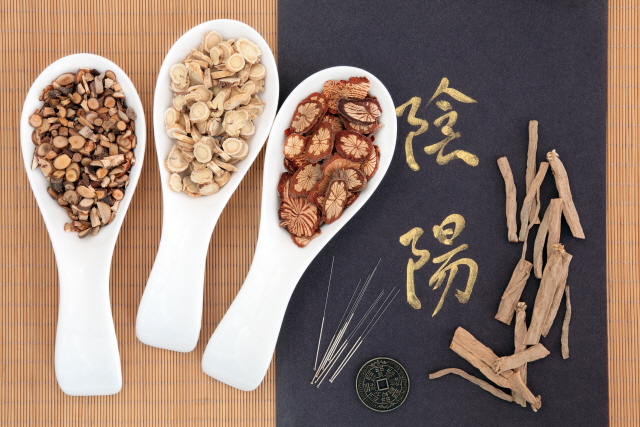
The Formula Is Used for Deficiency-type Shaoyang Syndrome
By Ju Bong Kang, KMD
<Ingredients>
|
Chaihu |
bitter, pungent, slightly cold |
柴胡 |
12g |
|
Guizhi |
pungent, sweet, warm |
桂枝 |
6g |
|
Gualougen |
sweet, slightly bitter, cold |
瓜蔞根 |
|
|
Huangqin |
bitter, cold |
黃芩 |
|
|
Muli |
salty, slightly cold |
牡蠣 |
|
|
Ganjiang |
pungent, hot |
乾薑 |
4g |
|
Gancao |
sweet, mild |
甘草 |
Actions and Diagnosis
Chaihu-Guizhi-Ganjiang-Tang is one of the Chaihu series of prescriptions and treats Shaoyang-syndrome of deficiency type, whose pulse is weak or sunken and tense. So this prescription relieves coldness in the lower limbs, palpitation on the navel, heart palpitation, head sweating, dry mouth, and insomnia, along with Fullness in the chest and hypochondria and slight binding, FCHSB and Alternating episodes of chills and fever, AECF. People who need to apply this prescription are digestible and prefer meat food but don’t like spicy food and usually have a sensitive personality.
Chaihu-Guizhi-Ganjiang-Tang, based on Xiao-Chaihu-Tang, has similar therapeutic effects and connects to formulas for various symptoms. Huang qin reflects its Xiao-Chaihu-Tang origin, Guizhi connects to Guizhi-Tang, Muli to Guizhijia-Longgu-Muli-Tang, and Ganjiang to formulas like Gancao-Ganjiang-Tang. Add Baizhu and Fuling for diarrhea, Banxia and Houpo for phlegm, Zhishi and Houpo for constipation, Shigao for thirst, Shudihuang for abdominal weakness or cold, and Huangqi for weak pulse and neurological symptoms. Among the constituent drugs of this prescription, Chaihu and Guizhi become monarch drugs.
Chaihu expels superficial evils through its pungent and cool properties, regulating Shaoyang and dispersing stagnated liver qi. It restores that feeling of fullness and oppression over the chest and hypochondria, FFOCH, Alternating episodes of chills and fever, AECF, bitter taste in the mouth, dizziness, tinnitus, depression, nervousness, shortness of breath, fatigue, lassitude, and menstrual irregularity.
Guizhi induces sweat, expels muscle waste, warms the channel, and promotes blood circulation, relieving Taiyang syndrome. It also improves headache, arthralgia, abdominal cold-type pain, foot cold, phlegm retention, dysuria, palpitation, and ‘running-pig’ syndrome.
In other words, these two drugs resolve and eliminate the pathological factors that occurred in the areas of Taiyang and Shaoyang by releasing and regulating them.
Huangqin and Gualougen become ministger drugs.
Huangqin clears away heat, purges fire, dries dampness and removes toxicity from pathogenic evils that are not sufficiently dispersed through superficies by Chaihu and Guizhi. This improves symptoms such as fever, cough, feeling of fullness and oppression, jaundice, diarrhea, nosebleeds, suppurative inflammation, metrorrhagia, hematuria, fetal anxiety, etc.
Gualougen promotes the production of body fluids, nourishes the lungs, clears away heat and removes toxicity, so it restores the symptoms of thirst, dry cough, diabetes, pyogenic infection and ulceration; it also replenishes impaired and deficient body fluids due to fire-evil.
Muli, Ganjiang, and Gancao have become adjuvant drugs that tranquilize the mind with heavy weight and astringe to preserve the essence. So, they improve the symptoms of palpitation due to fright and vexation, insomnia, dizziness, tinnitus, spontaneous sweating, night sweating, nocturnal emission, leukorrhea, etc.
Ganjiang has the functions of restoring yang and promoting blood circulation, drying dampness and warming the middle energizer, activating stagnancy, lowering turbidity and warming the spleen and stomach. Therefore, it recovers thin sputum, phlegm retention, nose running, cough, asthma, vomiting and diarrhea, and sore throat due to coldness.
Gancao regulates the middle energizer and alleviates spasm, invigorates the spleen and tonifying qi, moistens the lung, and stops cough from working as an adjuvant drug. It also plays a role in guiding drugs because it mediates all other drugs by the sweet flavor.
In diagnosis, the patient with this prescription has a weak abdomen, soft stool, and a feeble pulse. In many cases, there are symptoms of fullness over the chest and hypochondria, heart palpation, abdominal palpation, head sweat, thirst, cold on the waist and legs, and nerve symptoms such as heart vexation and insomnia.
Application
Treat the diseases below that include these symptoms: cardiac palpitation, abdominal palpitation, forehead sweating, night sweat, dry mouth, thirst, fullness feeling on the chest, cold foot, and weak wrist pulse:
- Cold, malaria, cough, asthma, otitis media, mumps, bronchitis, pulmonary inflammation, pulmonary tuberculosis, etc.
- Gastroenteritis, gastric ulcer, cholecystitis, jaundice, hepatitis, pyelitis, nephritis, Bashedow’s disease, diabetes, hypertension, etc.
- Mild fever, alternating chills and fever, unknown cause, nervous breakdown, fright and vexation, insomnia, etc.
Distinction
- Chaihujia-Longgu-Muli-Tang: This prescription improves neurological symptoms, heart palpitation, and abdominal palpitation. However, unlike Chaihu-Guizhi-Ganjiang-Tang, the wrist pulse is not weak, does not show a deficiency pattern, and is close to the excess pattern.
- Guizhijia-Longgu-Muli-Tang: Patients with this prescription have palpitation, neurotic symptoms, and sweating but no FFOCH and epigastric glomus.
- Xiao-Chaihu-Tang: In Xiao-Chaihu-Tang‘s provision of “Shang Han Lun,” the letter of ‘suffering’(‘苦’) is written with FFOCH, which is the signal-symptom of Chaihu, while in the provision of Chaihu-Guizhi-Ganjiang-Tang, instead of ‘suffering’(‘苦‘), the letter of ‘mild bind’(‘微結’) is written with FFOCH, which is the signal-symptom of Chaihu.
































![Supporting the Elderly [Appendix] 附養老 노인부양](https://theacupuncturetimes.com/wp-content/uploads/2021/06/AdobeStock_Evrymmnt-100x70.jpeg)